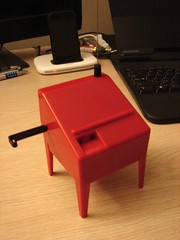Here's a picture of a miniature version that Kevin bought and assembled.

Initially I thought the word (pronounced "Ther-re-min") referred to some animal or drug name!
Then after watching Kevin's enthusiastic (but at times noisy) attempt at playing his miniatured version of a Theremin, my curiosity was stoked and ended up watching several videos of Theremin performances in YouTube.
This one blew me away!
And when I thought that was it, this one made my jaws drop:
Beautiful control.
I delved into more YouTube videos and found this one that explained how a Theremin is operated:
And then I learned more about the principles behind how a Theremin works, from this video:
Check out this post, that links to this:
In 1919 Leon Theremin made an interesting instrument called the Theremin, it works a bit like a metal detector, and was the first musical instrument designed to be played without using your hands - here's how to make one from "Popular Electronics November 1967"
Now I can appreciate Kevin's fascination with a Theremin. His mini-version wouldn't be able to generate the smooth tone of the professional models. But perhaps with practice, he'd be able to play just as good as this person, who uses a mini-version as well:
Searching the NLB Catalogue quickly, I couldn't find any books that might explain how a Theremin works. But the library does have some Audio/ Visual materials on the subject.
As of this post, the items are mostly at the library@esplanade, and are mostly reference items.
Incidentally, this post is a case in point how resources like YouTube and Wikipedia really does impact on the use of public libraries. But I'll elaborate on this is for another post.
[Related "unusual" musical instrument I've blogged previously: Chapman Sticks (Sept 06)]

It'll be so cool to do something on this and other electronic music at the library. Electro Fest or something.
ReplyDelete